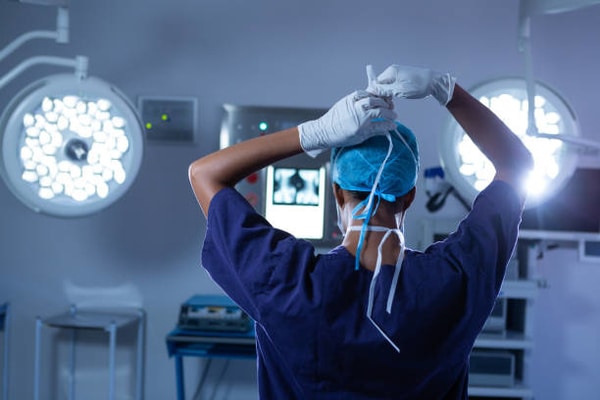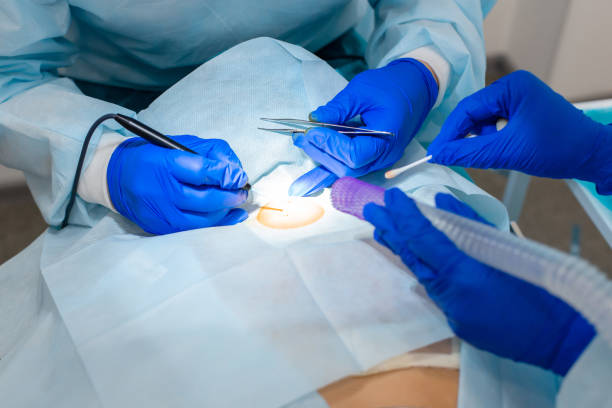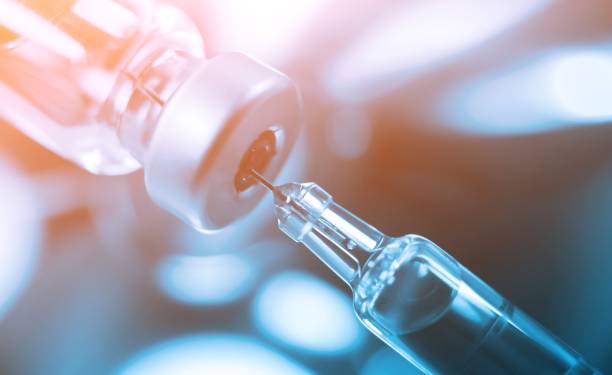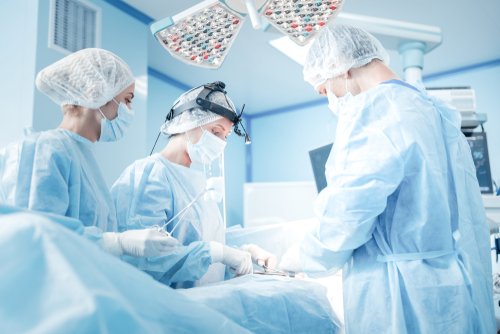
Potential Risks and Complications of Plastic Surgery
Dr Michael Kernohan will cover your plastic surgery risks and possible complications of surgery in detail during your consultation as part of your informed consent process. He will also do everything possible to manage and reduce your risks, however, surgical complications can still occur.
Surgery is a partnership effort between a surgeon and a patient – please do everything you can to get a great result. Follow instructions, rest, heal and allow plenty of time for recovery.
Risks and complications of surgery
Dr Michael Kernohan will discuss the risks and potential complications associated with plastic surgery as part of the informed consent process.
Surgery is a collaborative effort between the surgeon and the patient. To achieve the best possible outcome, it’s crucial that you actively participate by following Dr Kernohan’s instructions closely. This includes getting ample rest, maintaining a healthy diet, and allowing sufficient time for recovery to promote optimal healing. Above all, refrain from smoking, as it significantly increases the risks.
9 things you can do to minimise your risks and potential complications of surgery
- Quit smoking entirely throughout the entire surgical journey, with special emphasis on the periods before and after surgery.
- Thoroughly read all your surgical documents and strictly adhere to your surgeon’s instructions. Rest and give yourself ample time to heal. Wear compression garments as directed and avoid removing bandages or touching the incision site until it has properly healed.
- Provide accurate and honest information about all medications, supplements, vitamins, and even illicit drugs you are currently taking. Inform both Dr Kernohan and your anesthetist about these substances.
- When providing your medical history, be specific about any past difficulties you’ve had with surgery, anesthesia, hospital visits, or healing. It’s crucial to be honest and detailed, particularly regarding any allergic reactions.
- Prior to surgery, ensure you thoroughly wash your body to minimise skin bacteria and reduce the risk of infection.
- Being in good physical health before surgery can contribute to smoother recovery and improve the final results.
- Achieving successful surgical outcomes requires realistic surgical goals, reasonable patient expectations, and a comprehensive understanding of the potential risks of plastic surgery.
- Prepare in advance for a restful recovery by shopping for necessities, arranging for support, and avoiding stress and strain.
- Follow all medical instructions diligently, especially during the recovery period.

Risks of surgery and potential complications that may apply to any surgical procedure:
General Risks Associated with Surgery:
- Postoperative infection
- Bleeding or hematoma
- Poor scarring, including keloid scars
- Blood clots in legs or lungs
- Revision surgery needed to correct or improve the outcome
Specific Risks of Surgery:
- General Anesthesia: While anesthesia is generally safe, complications can occur. These range from minor issues like bruising at the injection site or a sore throat from the anesthesia tube to more serious problems like allergic reactions, which may necessitate stopping the surgery and extended hospital stays. If you have had any previous difficulties with surgery, anesthesia, or heart problems, inform your anesthetist.
- Pain: Minor post-operative pain may occur, and pain medication will be provided. In case of severe pain, contact Dr Kernohan’s office or the hospital immediately.
- Numbness/Nerve Damage: Sensory nerves may be damaged during surgery, leading to temporary numbness in the surgical area. Normal sensory feelings should return after a short period, but there is a risk of more permanent nerve damage.
- Internal Bleeding – Hematoma: While all known bleeding points are controlled during surgery, there is a possibility that a blood vessel starts bleeding after wound closure. Severe cases may require a return to the operating theatre for correction.
- Fluid Build-Up – Seroma: Following surgery, fluid may accumulate near the surgical site. If this occurs, a visit to the operating theatre or procedure room may be necessary to remove it.
- Infection: Infections can occur after surgery, despite precautions taken to maintain a sterile environment. Symptoms of infection include increased pain, redness, swelling, and discharge from the surgical site. Antibiotics may be prescribed to treat the infection, and in severe cases, additional procedures may be required to drain the infected area.
- Poor Wound Healing: Some individuals may experience delayed wound healing or poor scar formation. Factors that can contribute to this include poor blood circulation, smoking, certain medical conditions, and inadequate post-operative care. Following Dr Kernohan’s instructions for wound care and maintaining a healthy lifestyle can help promote optimal healing.
- Scarring: Scarring is an inherent part of any surgical procedure. While efforts are made to minimise visible scarring and place incisions in inconspicuous locations, individual healing and skin characteristics can influence the final appearance of scars. In some cases, scar revision procedures may be necessary to improve the appearance of scars.
- Unsatisfactory Results: Despite the best efforts of the surgeon, there is a possibility that the surgical results may not meet your expectations. It’s important to have realistic expectations and communicate openly with Dr Kernohan about your desired outcomes. In some cases, additional procedures or revisions may be necessary to achieve the desired results.
- Blood Clots: Surgery can increase the risk of blood clot formation, particularly in the legs (deep vein thrombosis) or lungs (pulmonary embolism). Steps are taken to minimise this risk, such as early mobilisation, compression stockings, and blood-thinning medications in some cases. Inform Dr Kernohan if you have a history of blood clots or if you are taking any medications that affect blood clotting.
- Anesthesia-related Complications: Although rare, complications related to anesthesia can occur, including allergic reactions, respiratory problems, and adverse reactions to medications. Your anesthesiologist will evaluate your medical history and take appropriate measures to minimise these risks.

- Nerve Damage: During surgery, there is a risk of damage to surrounding nerves, which can lead to temporary or permanent numbness, tingling, or loss of sensation in the treated area. Nerve damage can affect both motor and sensory functions and may require additional treatment or rehabilitation.
- Hematoma: A hematoma is a collection of blood that can accumulate under the skin following surgery. It can cause swelling, pain, and bruising. Small hematomas may resolve on their own, but larger ones may require drainage to prevent infection and promote healing.
- Seroma: Similar to a hematoma, a seroma is a collection of fluid that can accumulate under the skin after surgery. It may cause swelling, pain, and a sensation of fluid movement. Small seromas may resolve spontaneously, but larger ones may need to be drained to aid in healing.
- Adverse Reaction to Implants: If you are undergoing a procedure that involves the use of implants, such as breast augmentation or buttock augmentation, there is a risk of adverse reactions to the implants. This can include infection, implant rupture or leakage, capsular contracture (scar tissue around the implant), and changes in the shape or position of the implant.
- Changes in Sensation or Function: Depending on the type and extent of the surgery, there may be temporary or permanent changes in sensation, function, or range of motion in the treated area. This can include limitations in movement, muscle weakness, or altered sensory perception. Physical therapy or rehabilitation may be necessary to aid in recovery.
- Psychological Impact: Undergoing plastic surgery can have psychological effects, especially if the results do not meet your expectations or if you have unrealistic expectations. It’s important to have a thorough discussion with Dr Kernohan about your motivations, goals, and expected outcomes to ensure that you have a realistic understanding of what can be achieved.
- Allergic Reactions: Some individuals may have allergic reactions to certain medications, anesthesia, or materials used during surgery, such as sutures or implant materials. It’s crucial to inform Dr Kernohan about any known allergies or previous adverse reactions to minimise the risk of allergic complications.

- Scarring: Plastic surgery involves incisions, and as a result, scarring is a common outcome. While surgeons try to minimise carring by placing incisions strategically and using techniques to promote better healing, individual factors such as genetics and the body’s response to surgery can affect the appearance of scars. Some people may develop thick, raised, or keloid scars, which may require additional treatments like scar revision or laser therapy.
- Skin Discoloration: In some cases, changes in skin pigmentation can occur after plastic surgery. This can manifest as hyperpigmentation (darkening of the skin) or hypopigmentation (lightening of the skin). Skin discolouration can be temporary or permanent and may require additional treatments to address.
- Unsatisfactory Results: There is a possibility that the outcome of the surgery may not meet your expectations. Plastic surgery results can be influenced by various factors, including individual anatomy, healing processes, and surgical techniques. It’s important to have realistic expectations and to communicate openly with your surgeon about your desired outcomes to ensure you have a clear understanding of what can be achieved.
- Revision Surgery: In some cases, additional procedures may be necessary to achieve the desired results or address complications. Revision surgery can be more complex and may involve additional risks compared to the initial surgery. It’s important to discuss the potential need for revision surgery with your surgeon and understand the associated risks.
- Emotional and Psychological Effects: Undergoing plastic surgery can have emotional and psychological impacts, both positive and negative. While it can enhance self-confidence and improve body image for many individuals, it’s essential to consider the psychological aspects of the procedure. Unrealistic expectations, body dysmorphic disorder, or dissatisfaction with the results can lead to emotional distress. It’s crucial to have a support system in place and consider counselling or therapy if needed.
- Anesthesia Complications: Plastic surgery often requires the use of anesthesia, which carries its own set of risks. These can include adverse reactions, medication interactions, breathing difficulties, or complications related to anesthesia administration. An anesthesiologist or a qualified healthcare professional will monitor you closely during the procedure to ensure your safety.
- Infection: As with any surgical procedure, there is a risk of developing an infection. Surgeons take precautions, such as using sterile techniques and prescribing antibiotics, but infections can still occur. Signs of infection include increased pain, redness, swelling, warmth, or discharge from the surgical site. Prompt treatment with antibiotics is essential to prevent complications.
Other individual risks related to breast surgery, body surgery, skin, hand, face and nose surgery
Breast Surgery Risks and Complications
It’s important to be aware that they may still occur despite our best efforts.
Breast Procedures: Risks and Potential Complications
- Postoperative infection
- Bleeding or haematoma
- Poor scarring, including keloid scars
- Loss of sensation to the nipple and breast skin
- Revision surgery to correct or improve the outcome
- Inability to breastfeed
- Interference with breast imaging
- Capsular contracture
- Breast implant malposition
- Breast implant rotation
- Visible rippling within the cleavage
- Breast implant palpability
- Animation deformities
- Breast implant rupture or leakage
- Breast asymmetry
- Symptoms of Breast Implant Illness (BII)
- Anaplastic Large Cell Lymphoma (ALCL)
- Allergic reactions to anesthesia, such as skin rashes and difficulty breathing
- Changes in skin sensation
- Delayed wound healing
- Haematoma or hemorrhage
- Increasing pain at the surgical site
- Numbness in one or both breasts
- Possibility of revision surgery
- Pus draining from the wound
- Rippling of the implant
- Seroma
- Severe swelling
- Skin discolouration
- Skin loss
- Sutures that protrude through the skin
- Unwanted scarring
- Wound dehiscence
- Wrong or faulty position of the implant
Breast Reduction Risks and Complications
If you are considering breast reduction surgery, it is important to be aware of the potential risks involved. They may include:
- Partial or total loss of the nipple and/or areola
- Loss of sensation in the nipple
- Breast asymmetry
- Inability to breastfeed
- Lumpiness or fat necrosis
Breast Augmentation Risks and Complications
We want to ensure that you have a comprehensive understanding of the potential outcomes after a breast augmentation. While we take every measure to minimise complications, it’s important to be aware that they may still occur. During your consultation, we will discuss these risks in detail. They may include:
- Postoperative infection
- Bleeding or hematoma
- Graft failure or fat necrosis
- Poor scarring, including keloid scars
- Loss of sensation to the nipple and breast skin
- Revision surgery to correct or improve the outcome
- Inability to breastfeed
- Interference with breast imaging
- Capsular contracture
- Breast implant malposition
- Breast implant rotation
- Animation deformities
- Breast implant rupture
- Breast asymmetry
- Anaplastic Large Cell Lymphoma (ALCL)
Breast Implant Replacement Risks and Complications
In addition to general risks for breast implant replacement like adverse effects to anesthesia, scarring, infection, and bruising, there are additional risks to consider, like:
- Wrinkling of the skin over the implant 2
- Faulty position of the implant
- Breast Implant Illness (BII)
- Leaking or rupturing of the implant
- Capsular contracture
- Breast pain
- Additional surgeries to remove the ruptured or rotated implant
- Breast implant-associated anaplastic large cell lymphoma (BIA-ALCL)
Breast Lift Surgery Risks and Complications
Breast lift surgery risks may include:
General Risks and Complications:
- Wound breakdown and delayed healing
- Postoperative infection
- Bleeding or hematoma
- Poor scarring, including keloid scars
- Blood clots in legs or lungs
- Revision surgery to correct or improve the outcome
Specific Risks Associated with Breast Lift Surgery:
- Partial or total loss of the nipple and/or areola
- Loss of sensation in the nipple
- Breast asymmetry
- Inability to breastfeed
- Lumpiness or fat necrosis
Please keep in mind that the information provided here is not exhaustive and serves as a general overview of potential risks and complications. Dr Kernohan, we will address any specific concerns you may have. Please see your GP or Specialist for a referral.
For more comprehensive and authoritative information, we recommend referring to reputable medical sources such as:
- American Society of Plastic Surgeons (ASPS):
- Mayo Clinic:
These resources provide valuable insights into the risks, benefits, and considerations associated with various breast procedures.
Body Surgery Risks and Complications
General Body Surgery Risks
- Allergic reaction to anesthesia, which may manifest as skin rashes or difficulty breathing
- Body weakness
- Capsular contracture
- Changes in skin sensation
- Delayed wound healing
- Hematoma (localised collection of blood)
- Hemorrhage (excessive bleeding)
- Increasing pain at the surgical site
- Numbness in one or both sides of your body
- Pus draining from your wound
- Rippling of the implant
- Severe swelling
- Skin discolouration
- Skin loss
- Sutures that protrude through the skin
- Unwanted scarring
- Wound dehiscence (wound reopening)
Learn more about the body surgery procedure.
Abdominoplasty Risks and Complications
In addition to the general surgical risks, abdominoplasty or tummy tuck surgery carries its specific risks. We will provide detailed information about these risks. Here are the specific risks and complications associated with tummy surgery:
- Fluid accumulation or seroma formation
- Partial or total loss of the umbilicus (belly button)
- Loss of sensation to the abdomen
- Wound breakdown and delayed healing
- Scar asymmetry
- Lumpiness or fat necrosis
For further information and reference, we recommend visiting reputable medical sources:
- Australian Society of Plastic Surgeons (ASPS):
- Mayo Clinic:
Liposuction Surgery Risks and Complications
Similar to other surgeries, liposuction carries its own set of risks and complications.
- Postoperative infection
- Bleeding or hematoma (collection of blood)
- Poor scarring, including keloid scars
- Blood clots in legs or lungs
- Revision surgery to correct or improve the outcome
- Numbness to the overlying skin
- Asymmetry with over or under correction
- Skin irregularities, ripples, or discolouration
- Fat embolism, which can be life-threatening
- Lumpiness or fat necrosis
- Temporary or permanent pain
- Damage to deeper structures/organs
Further medical resources:
- American Society of Plastic Surgeons (ASPS):
Gynecomastia Risks and Complications
For gynecomastia surgery, the following risks may occur:
Here are the specific risks and complications that may occur with gynecomastia surgery:
- Visible scars: While efforts are made to lessen scarring, some degree of visible scarring may occur.
- Infection: Although rare, there is a small risk of developing an infection after surgery.
- Bleeding: There is a possibility of bleeding during or after the procedure, which may require medical intervention.
Specific risks associated with gynaecomastia surgery:
- Irregular chest contour: Achieving a perfectly symmetric chest contour may not always be possible, and slight irregularities may persist.
- Asymmetry: The final result may not exhibit perfect symmetry between the breasts.
- Persistent tissue: In some cases, glandular or fatty tissue may persist after surgery, requiring further treatment or revision surgery.
- Nipple sensation changes: Temporary or permanent changes in nipple sensation, including increased or decreased sensitivity, may occur.
- Recurrent gynaecomastia: Although rare, there is a small possibility of gynaecomastia reoccurring after surgery.
More Resources:
- Australian Society of Plastic Surgeons (ASPS):
- Mayo Clinic:
Please note it is our priority to ensure your safety and well-being throughout your plastic surgery journey.
Risks and complications associated with facial surgery
Let’s discuss the risks and complications associated with facial surgery, like facelift, neck lift, blepharoplasty and rhinoplasty. Your safety and well-being are our utmost priority, and it’s important to have a clear understanding of these potential risks. I will provide you with a detailed overview in a caring and calming manner.
Facelift Surgery Risks:
- Wound breakdown and delayed healing
- Bleeding or hematoma
- Postoperative infection
- Poor scarring, including keloid scars
- Revision surgery to correct or improve the outcome
- Hair loss or changes in the hairline position
- Skin flap necrosis
- Facial nerve injury with weakness
- Numbness
- Pigmentation changes
- Asymmetry
Neck Lift Surgery Risks:
- Anaesthetic risks
- Bleeding from the incision site
- Facial asymmetry
- Accumulation of fluid or hematoma
- Infection
- Changes in skin sensation around the incision site
- Irregularities and discolouration of the skin
- Loss of skin
- Sutures may produce irritation or pop up and need to be removed
- Temporary or permanent loss of hair at the incision site
- Prominent scarring
- May require revision surgery
Eyelid Lift Surgery (Blepharoplasty) Risks:
- Swelling
- Poor scarring
- Infection
- Bruising or hematoma
- Revision surgery to correct or improve the outcome
- Pigmentation changes
- Dry eyes
- Ectropion or entropion (eyelid malposition)
- Inability to close eyes
- Eyelash loss
- Ptosis (drooping eyelid)
- Asymmetry
- Altered vision or blindness (rare)
Rhinoplasty (Nose Surgery) Risks:
- Postoperative nosebleeds
- Cartilage grafts may leave additional scars (donor sites)
- Asymmetry
- Nasal septal perforation
- Nasal airway alterations
- Numbness
- Chronic pain
It’s important to note that these risks can vary depending on individual circumstances. If you have specific medical conditions such as thyroid problems, dry eye, high blood pressure, circulatory disorders, or a history of detached retina or glaucoma, please inform Dr Kernohan before undergoing any procedure.
For additional information and references, we recommend consulting reputable medical sources:
- Australian Society of Plastic Surgeons (ASPS):
- Mayo Clinic:
Always remember that these risks and complications are discussed to ensure your well-being and to provide you with a comprehensive understanding. Dr Kernohan will address any further questions or concerns you may have during your consultation.





